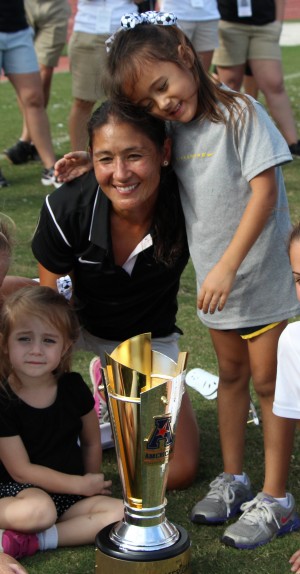This Fil-Am was a FIFA Women’s World Cup champ

Tiffany Roberts when she played for the U.S. Women’s National Team: U.S. vs Brazil. CONTRIBUTED PHOTOS
I know just how crazy it can get anywhere you get a bunch of little girls with big dreams, juggling a soccer ball with only their feet.
And that’s why diversity is important in a game like soccer.
Imagine how the presence of an American Filipino on a team like the U.S. Women’s National Team–the newly minted Women’s World Cup champs for 2015–would be an inspiration for female Filipino soccer players of any age.
You have to go back to the 1999 U.S. Women’s National Team–the team that won the Women’s World Cup and exposed Brandi Chastain’s sports-bra– to find a player with a drop of Filipino blood on a roster.
But there was one: Tiffany Roberts, now Tiffany Roberts Sahaydak.
The Filipino American from Northern California, drew attention early on as a 15-year-old, and first played for the national team at age 16. She became a two-time NCAA Champion at North Carolina, an Olympic Gold medalist, and then the 1999 Women’s World Cup Champion.
But she told me on the phone this week, if her Filipino mom had won the arguments with her Caucasian father, Tiffany would have been pushed more to music and singing, another one of her loves.

Tiffany Roberts Sahaydak, now an NCAA soccer coach in Florida, with her own daughters, future soccer stars.
That’s the competition where you see the little Filipino girls winning—in the entertainment realm. How many sub-teen vocal phenoms do you know who can channel Whitney Houston?
Instead, Tiffany’s father, a former track athlete, and the one who gifted her his speed, pushed her into soccer. And it’s been an amazing career.
The current World Cup champs could use a few more Tiffany’s—just for diversity’s sake. But they’re hard to find.
In recent weeks, the team has been criticized for its physical and direct style of play, far from the “beautiful game” from the streets of Brazil, and more typical of its natural U.S. environment, the white suburbs of the soccer mom.
The team picture only reinforces an image of U.S. women’s soccer as a game of privilege. But Tiffany isn’t about to throw the current champs under the bus for its lack of diversity.
“I think diversity is great, but you don’t want to force that just to say you have a diverse team,” said Roberts Sahaydak who was in Florida, where she is now head coach of the University of Central Florida.
“It doesn’t mean if you’re diverse you will be better,” Roberts Sahaydak said. “In 1999, we had a diverse team that was the accumulation of the best players in the county at that time. This time it wasn’t as diverse, but it doesn’t mean there aren’t capable players out there,” she added. “We have to do more to reach out to communities besides white suburbia and find ways to make (soccer) more affordable to families that can’t afford youth soccer, since it’s so expensive.”
Roberts Sahaydak said the costs can amount to thousands of dollars a year just to join the best youth team, to get the best coaching and to be seen at the top tournaments. Often she said the motivation for many girls is to get an athletic scholarship to an elite college, and not the love of the game.
As the head coach of a winning NCAA program at the University of Central Florida, she recognizes the challenge to field a diverse team. But admits it’s not the driving factor in her recruiting.
“We just need the best players,” Roberts Sahaydak said. “We’re not looking for an Asian kid, or an African American kid. I’m looking for the best players out there to help me win, and I think that’s what the U.S. team does.”
To Roberts, the real value of diversity is to motivate younger players who see themselves as elite players.
“You want the diversity so that young kids can attach themselves to a player, instead of kids saying, ‘I don’t know if I can play at that level, I don’t see anyone like me,’” Roberts Sahaydak said. “For me, that makes an impact.”
When you see a Filipino like Tiffany who has had a brilliant soccer career on the international level, it is as positive a reminder as you can get.
Filipino soccer players? Yes, we can.
Emil Guillermo is an award-winning journalist and commentator based in California.
Contact: www.amok.com, www.twitter.com/emilamok, www.fb.com/emilguillermomedia
Like us on Facebook